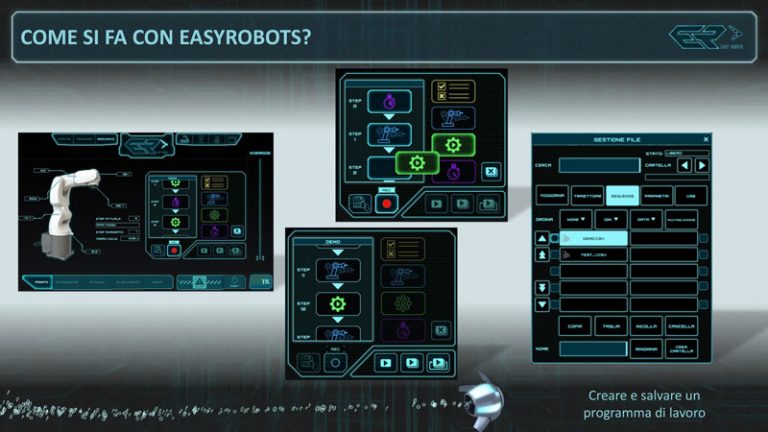Now Everyone Can Program Robotic Cells
How can a company which does not have in-house technical skills in PLC and robot programming insert robotic cells into its line? The answer comes from Asotech, the Emilia-based company which created EasyRobots, an easy-to-use, web-based software for programming the operation of anthropomorphic robots. It is possible to control the functions of the robot, the tools and the work program entirely using a smartphone, tablet or computer, thanks to a simple and intuitive interface. The solution was officially presented on September 23rd and will be available on the market shortly.
Is it possible to program and manage the operations of anthropomorphic robots from smartphones or tablets even for those who are not programming experts? This was the question Asotech wanted to answer when it decided to develop EasyRobots, a software solution for programming a robotic cell. It is a web-based operator interface, designed also for users who do not have the technical skills for anthropomorphic robot and PLC programming. But who is Asotech? Four partners, a group of more than 100 professionals and a portfolio of more than 70 customers in Italy and Europe are the figures of this engineering firm which has been operating since 1996 and is based in Sant’Ilario d’Enza, near Reggio Emilia. “We were born in what is called the food and motor valley,” Davide Mavillonio, Head of the Technical Calculation Service Department, said, “so we are highly specialised in industrialisation and automatic filling and packaging machines in the food sector, but also in all things automotive. Over the years, at any rate, we have also expanded into many other sectors”. Besides mechanical and plant design, Asotech has a dedicated hardware and software department for industrial automation, which mainly deals with PLC, robotics, HMI, motion and supervision, where EasyRobots was born. This software aims to be the first product of its kind conceived, developed and marketed entirely by Asotech. “At the beginning of 2019 we started developing EasyRobots”, Erik Levada, Technical Director of Asotech, stated, “and we started from a question raised by many of our customers: in the field of anthropomorphic robots is it better to use a traditional industrial robot or a collaborative one? We replied by trying to create an application which would exploit the advantages of both types of robot to make it easy to program industrial anthropomorphic robots so as not to have to do without their qualities”.

Combining the advantages of cobots and industrial robots
Both the traditional industrial robot and the collaborative robot, therefore, bring with them strengths and weaknesses to be taken into account. Asotech’s idea in the creation of EasyRobots was to take the best of both worlds to create a flexible and versatile software which would simplify the management of more or less complex robotic cells. “If we analyze the strengths of the collaborative robot,” Erik Levada explained, “we see that its greatest advantage is that it is ready to use, which means that it requires no special programming other than that of the movement trajectories. Another great advantage of the cobot is that in theory it does not need a safety system, as it was built to be a machine capable of working in close contact with the operator”. But there are also intrinsic disadvantages of the collaborative robot. “Unfortunately, it is not true that it never needs a safety system,” Erik Levada continued, “if it is used to handle dangerous objects, it is necessary to create a protection system. At the same time, however, it cannot exceed 250 mm/s speed in its movements, precisely because it is designed to work alongside humans. Moreover, these robots are very expensive due to the high level of technology”. The industrial robot, on the other hand, has a wide range of choices because it can cover much greater playloads and the working range is also wider; besides, it costs about half of its collaborative counterpart. “But it has a number of intrinsic complications,” Erik Levada continued, “the safety system is always necessary and it must therefore be installed in a protected area whatever job it has to carry out. Moreover, the big disadvantage compared to the cobot is the need to have someone with high programming skills: a specialized technician is required who is able to ‘enter’ the robot and develop the management logic of its missions together with movements and trajectories”. What EasyRobots wants to do, therefore, is to simplify communication and programming of the industrial anthropomorphic robot as much as possible, thanks to a highly user-friendly interface understandable even by those who do not have in-depth technical knowledge. Besides, the software not only controls the robot, but also all the tools connected to it. To date, EasyRobots supports B&R PLCs, but with plans to expand to others. Regarding robots, on the other hand, Kuka controllers are currently supported, but even in this case there are plans to expand the choice. The system is installed by inserting a CF memory card inside the PLC controlling the automation system, while no code is written into the robot: this has been thought of to be able to match the software to any size of robot. EasyRobots will be marketed with a user license, with a one-off cost depending on the modules to be added, such as the Data and Safety modules.

The advantage of the software: the operator interface
“The operator interface is what we have obviously worked on the most,” Erik Levada pointed out, “because it is precisely what allows the operator to interact with our robotic cell. It is a completely web-based interface, based on HTML5, Java and CSS languages; it can be displayed on any browser and does not require industrial operator panels, since a smartphone, tablet or PC with Chrome is enough”. The operator interface is divided into three parts: handling, trajectory creation and work program creation. To show how it works, Asotech brought an example of handling and assembly carried out with an anthropomorphic robot, SCHUNK’s Co-Act gripper and a SCHUNK pneumatic vice.
The first step to program the work of the robot and its tools is to define their movements. Easyrobots has a main page on which the status, the robot positions (both in axis and Cartesian coordinates), the override, the alarm status which is activated if necessary, and all machine functions are displayed. “We do not need to use the robot’s teach pendant,” Erik Levada explained, “but all movements can be reproduced using the application. Jog-type movements are possible, which can be performed in both axis and Cartesian coordinates. There is the possibility of performing movements in relative jog, that is, moving the robot by a predetermined distance with respect to the robot’s position. It is also possible to move the robot to a predetermined position, setting the coordinates of the position”. The novelty brought by EasyRobots is the manual guide of the industrial robot, a type of movement normally not possible with anthropomorphic robots but typical of cobots, further facilitating the programming of trajectories: with this mode it is possible to move the robot by dragging it by hand, or by taking the tool and pulling it to the position of interest. In addition to the commands for the robot, patches dedicated to the tools have been developed: through the interface it is possible, for instance, to check the LEDs on the gripper, or give it the open/close commands. “It is not necessary to create a patch for every tool,” Erik Levada continued, “in our demonstration, the pneumatic clamp does not have one, but it can be controlled like a digital output”.
After setting the types of movements, trajectories are acquired. As mentioned earlier, performing this operation on an anthropomorphic industrial robot requires a person with technical PLC and robot programming skills: all of this is replaced and absorbed by EasyRobots, while the operator only has to enter data into the interface. “The acquisition of trajectories with the application – Erik Levada explained – is carried out in the ‘teaching’ screen, where, besides creating them, it is possible to store and save them. There are two ways to save a movement trajectory: the first is ‘by positions’, that is, saving points in space which the robot will use to create its trajectory; the second mode is ‘by trajectory’, that is, making the robot go through a certain movement which will be saved exactly as it has been performed, and will therefore be performed several times exactly as it has been created, which is very useful with manual guidance”.
After choosing the types of movements and trajectories, it is necessary to set the work program of the robotic cell. The sequences are based on a library of control, movement, action and if necessary standby. Once they have been created, they must be integrated into a work program using the “step” mode: a program where the robot is told what to do and in what order. “Let’s consider the example of picking up an object – Erik Levada demonstrated – in the first step I will check that my gripper is open, then I will insert a control object and configure my gripper; then I must insert the movement step which will lead the robot to the gripping position, inserting one of the saved trajectories; if necessary, a standby step can also be introduced; then the action step follows, where the gripper is instructed to close to pick up the object; finally, in the case of an assembly, the vice step which will secure the workpiece is configured”. If there are any errors, it is sufficient to delete incorrect steps and eventually replace them, as you would with computer files; moreover, it is possible to modify the inserted steps in a few seconds. For more complex machining operations, it is possible to record sequences to be performed in parallel or ask robots to “ skip “ from one to the other under certain conditions. All the files of the trajectories and work programs can be copied and transferred via USB. On the interface, moreover, it is always possible to see in real time what the robot and its tools are doing, literally “step by step”, so as to be able to better control the cell and calculate precisely the working time and production performance. Asotech is already working on numerous updates to the step library, which will be enriched over time, such as the integration of the vision system. “What we wanted to do,” Erik Levada concluded, “was to create software to help companies not employing specialised personnel to become more independent and speed up production: with the traditional method, making a change to the cell’s programming would take at least a day’s work; with EasyRobots it takes 15 minutes. A great advantage, isn’t it?”.

